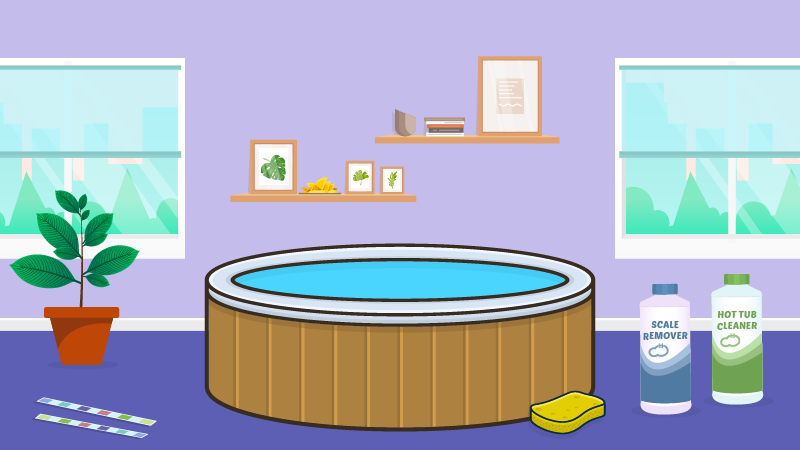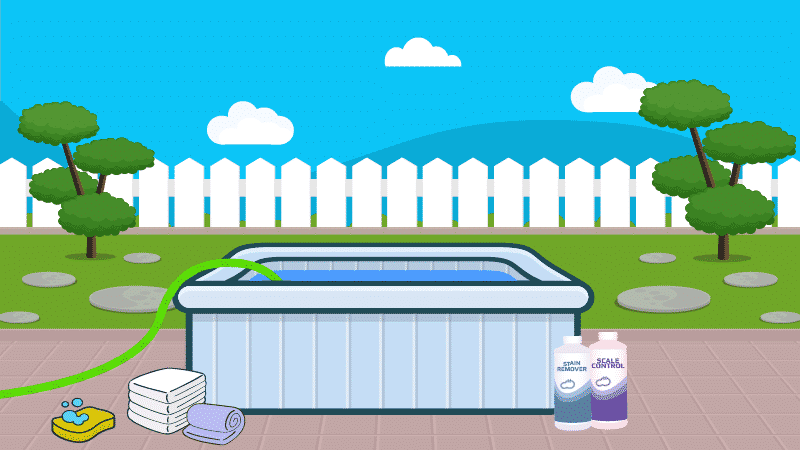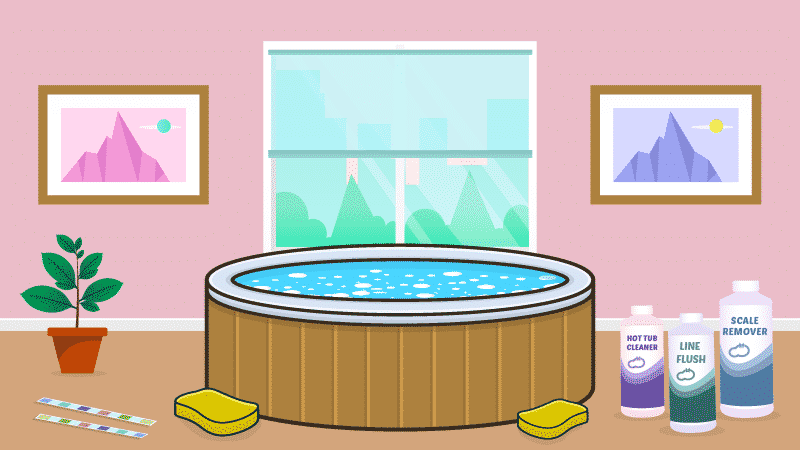How to Get Rid of Foam in a Hot Tub
How do you get rid of foam in a hot tub or swim spa? The fastest way is to use a Hot Tub Defoamer (Anti-Foam). This will quickly remove the foam so you can enjoy a soak. But it’s likely to come back and keep happening.
In order to solve constant hot tub foaming, you need to understand what causes it to prevent it. Here’s a simple guide on how to get rid of hot tub foam. You can watch the quick video below or keep reading for a complete hot tub foam tutorial.
My fool-proof system for keeping any hot tub clean and clear at all times. Our course covers every type of hot tub, including portable spas, inflatable hot tubs, inground hot tubs, swim spas, and more. This is the LAST and ONLY hot tub guide you'll need.
What Causes Foamy Hot Tub Water?
Foam needs three things: water, air, and surfactants to appear. Surfactants are super-sticky molecules that reduce the surface tension, which makes it easier for substances like oil and water to mix. This makes the water viscous or “thick.” Think about adding cream to your coffee.
Your hot tub contains water and some surfactants, even if you properly maintain your hot tub chemistry. But if you slip a little on your maintenance schedule, you might flip on your jets and find yourself with a foamy mess. The more surfactants you have, the more bubbles (foam) you get.
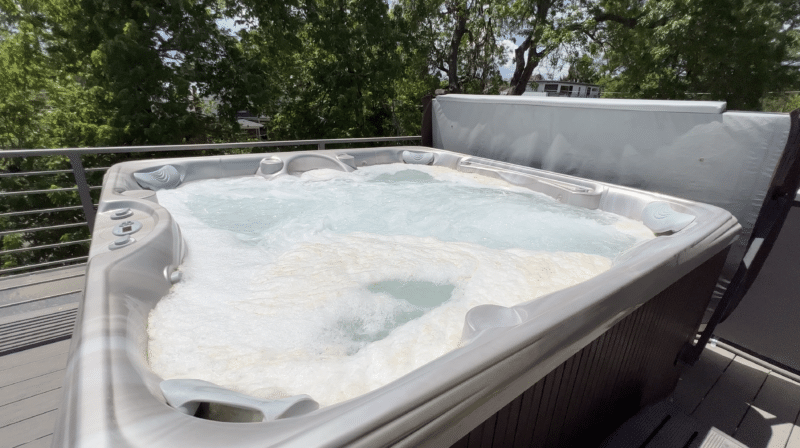
The main foam-causing culprits in your hot tub are…
- Personal Care Products: Makeup, body lotions, and deodorant.
- Hair Products: shampoo, conditioner, and hairspray.
- Laundry Detergent and Soap: Yes, wash your swimsuits, but any leftover detergent in the fabric can really mess with your water’s chemical balance.
- Beverages: Spilling alcoholic or sugary beverages in your carefully tended water can lead to foaming.
- Human Bodies: The human body can produce oils, dead skin cells, and other waste. That’s why you have sanitizing chemicals in our hot tubs.
- Cheap Chemicals: They may not be as effective or as concentrated as more expensive options. Even worse, those cheap chemicals could actually cause a buildup of surfactants and a whole slew of other water chemistry problems.
If your sanitizing agents are overburdened with body oil and dead proteins, you’re probably going to have a bubble bath instead of a hot tub.
Can you test the hot tub water for surfactants?
Yes! You can buy test strips or a liquid test kit that tests for total dissolved solids (TDS). If you have a high TDS reading, you have high surfactants. However, this is not necessary to do if you drain and clean your hot tub every 3-4 months. Total dissolved solids are the result of “too much crap” in your water. That includes hot tub chemicals, oils, dead skin cells, etc.
The Best Way to Get Rid of Foam in a Hot Tub
While clearing a hot tub full of foam may seem like an impossible, messy task, it’s actually pretty simple.
1. Test Your Water
Before you do anything corrective, test your spa water to find out what your pH and alkalinity water balance. And your current sanitizer levels (chlorine or bromine). Knowing what your water chemistry looks like after foaming can help you understand how to avoid the problem in the future.
- Ideal pH Level: 7.4 to 7.6
- Ideal Total Alkalinity Level: 100 to 150 ppm (as low as 80 ppm is OK)
- Ideal Chlorine Level: 1 to 3 ppm (0.5 to 1 ppm if you have a mineral sanitizer)
- Ideal Bromine Level: 3 to 5 ppm
Another thing to note is low calcium hardness levels may cause foam in your hot tub. Low calcium means you have soft water. It can cause other problems, too, like corrosion and etching on your finishes. So, it’s important to regularly test these levels as well.
Tests for 7 important chemistries in seconds: Total Hardness, Total Chlorine, Total Bromine, Free Chlorine, pH, Total Alkalinity, and Cyanuric Acid.
2. Drain and Refill
Once you’ve tested your water and made note of all the chemical levels, the best thing you can do to get rid of the foam is to drain and clean your hot tub. If you have enough surfactants in your water to cause foaming, you may also need to do a line flush and replace your filters.
Since you need to drain your hot tub anyway, this is the perfect time to perform a hot tub deep clean as well.
Basic Steps to Drain Your Hot Tub:
- Use a line flush product, as needed, according to the package directions. This removes biofilm that builds up in your plumbing. This gunk is caused by lotions, cosmetics, and bodily waste.
- Remove the filters. Depending on how dirty they are, you can either clean them with a cartridge filter cleaner or replace them.
- Turn off the power to your hot tub, disconnect anything electrical, and trip the breaker.
- Drain your hot tub using a sump pump or the drain plug.
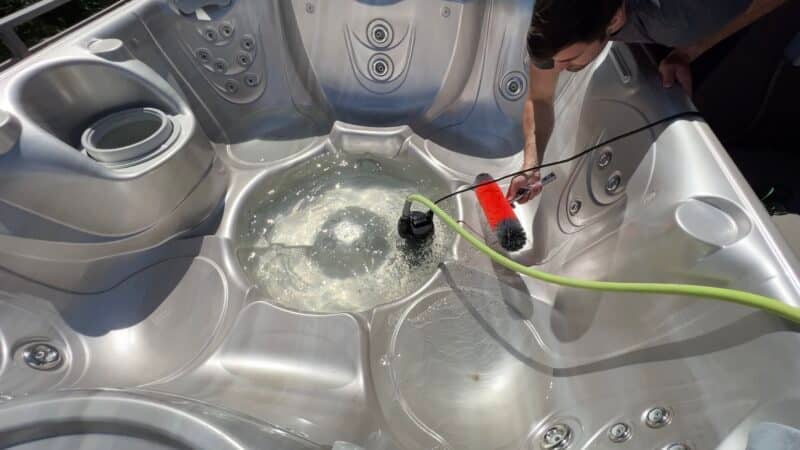
Basic Steps to Clean and Refill Your Hot Tub:
- Once your hot tub is entirely drained, wipe down the interior surface with a mixture of one part white vinegar to four parts water. Or you can use hot tub cleaner.
- Thoroughly rinse the inside of your hot tub and wipe it down.
- Make sure to remove all traces of the cleaner. Otherwise, you’ll end up with foamy water again!
- Replace your hot tub filters.
- Refill your hot tub. I recommend you use a hose filter attached to your garden hose to prevent chemical impurities.
After you’ve drained, cleaned, and refilled your hot tub, test the water, add chemicals, and allow the water to circulate for at least a day. When the circulation is complete, test the water one more time to ensure it’s ready for soaking.
Our hot tub kit makes taking care of your water easy. It includes Hot Tub Weekly Cleanse, Detox, and Filter Cleanse to use every 3-4 months for deep cleaning.
For Quick Fixes: Anti-Foam Hot Tub Chemicals
Say you’ve got a party coming up and not enough time to go through all the steps to correct a foamy hot tub. You can buy a foam remover chemical, which will get rid of the foam in your hot tub almost instantly and can last for up to 24 hours.
Remember, foam remover chemicals do not address the cause of foam in your hot tub. It just relieves the problem for a little while. You’ll still need to drain and refill your hot tub to get rid of the foam for good.
A quick relief to reduce foam in your hot tub. But not a complete remedy.
How to Prevent Hot Tub Foam
- Shower before soaking in the hot tub to remove any soap residue, makeup, or deodorant. It doesn’t have to be a full shower. Just a quick rinse is enough.
- Rinse your clean bathing suit with fresh water before getting in your hot tub.
- Avoid dunking your head underwater unless you’re sure your hair is free (or as free as possible) of natural oils, conditioner, and styling products. If you or one of your guests has long hair, tuck it in a baseball cap or pull it into a bun to keep it out of the water. This goes for beards, too.
- Keep sugary or alcoholic drinks away from the hot tub. This eliminates the chance of something spilling in the water.
- Buy your chemicals from a trusted source, even if you end up paying a little more. You’ll thank yourself in the long run.
- Maintain a regular hot tub maintenance schedule. This includes weekly or biweekly water testing and a full hot tub draining and cleaning every three to four months.
Frequently Asked Questions About Hot Tub Foam
I asked over 15,000 hot tub owners via email if they had any questions about getting rid of hot tub foams. These are the questions they asked, and here are my quick answers.
Is foam OK in a hot tub?
A little foam when jets are on is normal, but excessive foam indicates a water imbalance or contamination. It’s a sign to check your water chemistry.
Will shock get rid of foam in a hot tub?
Shocking can help if the foam is due to organic contaminants, but if it’s caused by soaps or oils, you might need to drain and refill your tub.
Will hot tub foam go away?
Foam will disappear if you correct the water imbalance or contamination causing it. Sometimes, a simple water change does the trick.
Does high pH cause foam?
Not directly, but high pH can lead to imbalances that make foam more likely. Balanced water is less foamy water.
Does baking soda reduce foam in hot tubs?
Baking soda won’t directly reduce foam. It’s used to raise alkalinity, which can indirectly help if low alkalinity is causing the foam.
Does vinegar get rid of foam in a hot tub?
Vinegar isn’t a go-to solution for hot tub foam. It’s more about balancing chemicals and cleaning out contaminants.
How often can you use a defoamer in a hot tub?
Use a defoamer as needed, but if you’re using it often, it’s time to check and correct your water chemistry.
Does too much chlorine cause foam in a hot tub?
Excess chlorine itself doesn’t usually cause foam. Foam is more often due to organic contaminants or imbalances in your water chemistry.
3 More Ways We Can Help With Your Hot Tub
- Hot Tub Cheat Sheets (Free): Easy-to-use guides to help you keep your hot tub water balanced and sanitized.
- The Hot Tub Handbook: An illustrated guide to DIY hot tub care, including water chemistry, maintenance, troubleshooting, and more.
- The Hot Tub Care Course. You’ll get step-by-step videos and a step-by-step downloadable guide with everything you need to know about hot tub maintenance.










